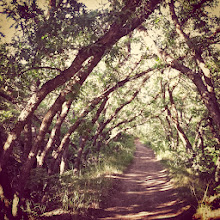
Attending art classes this fall has exposed me to some wonderfully inspiring artists. One in particular whose talent, vision, and method I greatly admire is the New York born/based artist, Tara Donovan.


Born in New York in 1969, Donovan received her BFA in 1991 from the Corcoran College of Art, in Washington DC. Afterward, she waited tables for six years before earning her MFA, and didn't quit her day job until her first solo exhibit in NY in 2003 proved to be a success. In 2008, she won the MacArthur Fellowship Genius Award, and has had shows at the Pace Gallery and Metropolitan Museum of Art in New York, among others.


From a distance her sculptures appear to be beautiful homages to naturalistic structures, made from polymer plastic, or graphite, or some expensive material manufactured just for her show.
But what could it be?...

...Styrofoam Cups

But in fact, her sculptures are made from everyday "found" objects such as Scotch Tape, drinking straws, tooth picks, buttons, paper plates, and Styrofoam cups. Upon even closer inspection, I was blown away to realize the sheer mass of individual objects present and the number of man-hours required to complete the overall impression.
?...

...Buttons

Donovan takes commonplace materials and "grows" them through a process of massive accumulation, sometimes called "generative art". Using a basic structure as a guide, Donovan creates a system of processes that she then repeats in incremental units to seemingly infinite possibilities. The results are large-scale abstract floor and wall works suggestive of landscapes, clouds, cellular structures and even mold or fungus.
?...

...Mylar

?...

...Pencils

Here is a beautiful seaweed-looking piece that consists of 2,500 pounds of plastic sheeting, loosely folded into a wide box that is glassed in the front and back, and built into a freestanding white wall. The light streaming in from the other side is all natural sunlight.



Even though Donovan's sculptures look entirely organic, "it is not like I'm trying to simulate nature," she says, "It's more of a mimicking of the way of nature, the way things actually grow." She considers patterning, configuration, and the play of light when determining the structure of her works, but the final form evolves from the innate properties and structures of the material itself.
?...

...Paper Plates

?...

...Pins

What a great method for appreciating the complex formation of natural structures that exist all around us! Just like Donovan's button sculptures were constructed piece-by-pice through a repetitive motion over thousands of man-hours, so are naturally occurring formations like caves, stalagmites, geodes, ant hills, pearls, coral reefs, and canyons, all developed through slow and steady processes, drip-by-drip, inch-by-inch, deposit-by-deposit, for thousands or even millions of years.



Perhaps more striking than the inherent beauty in nature is the knowledge that it takes so long to create itself, and yet it is so delicate and easily destroyed. I'm sure after an art assistant helped Donovan create one of those fuzzy "fungal" shapes out of thousands of strings of fishing line (shown below), they had a greater appreciation for the slow and intricate processes that nature undertakes to grow simple structures.


One example of Donovan's system of processes is the way she forms her large-scale on-site cubes made of tooth picks, metal pins, and broken glass.


First a wooden frame in the shape of a cube is built; then thousands of pins/toothpicks are systematically laid down inside the frame in a crosshatching pattern. In the case of glass, a single sheet is laid down, shattered with a chisel, then another is laid down, shattered, and another, and another, until hundreds of broken sheets sit several feet tall. Once the frame is removed, gravity and pressure hold everything together; no glue. If a corner is broken, the entire structure must be made over again. By the end of an exhibit each cube is simply swept away.

It seems rather wasteful, I hope they reuse the materials.


Donovan's methodology really speaks to the beauty inherent in mass and pattern. Anything, even if it is a generic plastic cup, can look beautiful when paired with thousands of its kind and organized in a systematic pattern.


It kind of reminds me of that documentary, Manufactured Landscapes, an award-winning film about renowned artist Edward Burtynsky, whose large-scale photographs portray the devastating impact of industrialized expansion on the environment.



These landscapes are disturbing to say the least. They depict the materials and debris of civilization--quarries, recycling yards, factories, mines and dams. Despite their provocative nature about the ethics of impacting our environment, there is something undeniably aesthetic about their patterns. Even an ugly stone quarry or a pile of old tires can look strangely beautiful when compacted together and viewed from a distance.


Despite the fact that man-made trash can look beautiful when amassed together, I think I prefer Donovan's organic sculptures because they mirror patterns found in nature which can only occur when the environment is left to grow and flourish on its own, as opposed to the rigid and forced nature of our manufactured landscapes which look unhealthy, and make us feel guilty about negatively impacting our environment. A lush forest will always look more beautiful than an oil field, no matter what you do.


Well, this is how you know you've found good art. When it makes you think about your world on so many different levels. I will continue to ponder the varied dimensions of Donovan's work whilst looking forward to her future conceptual sculptures. Like all her works, I'm sure they will be marvelous creations to behold.
~S



